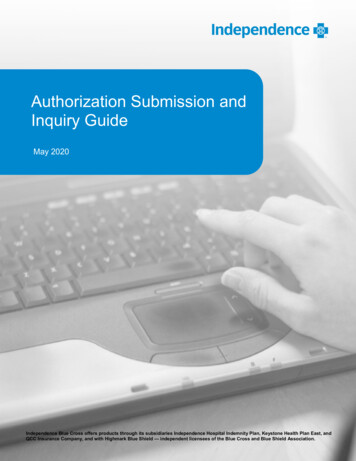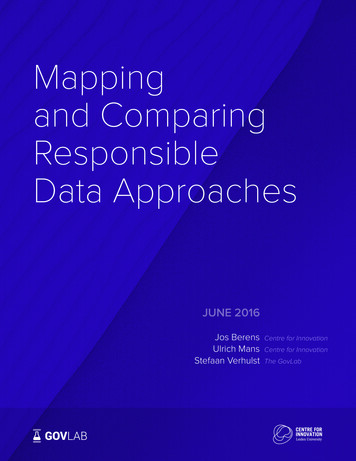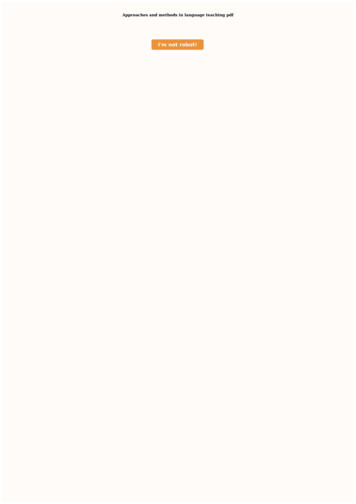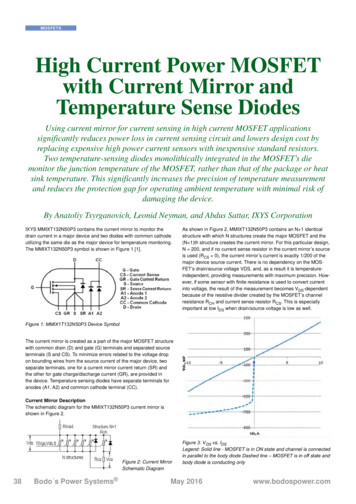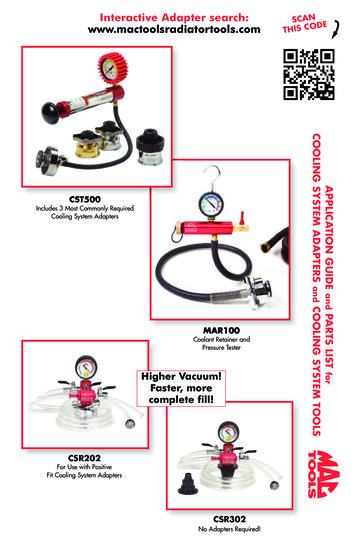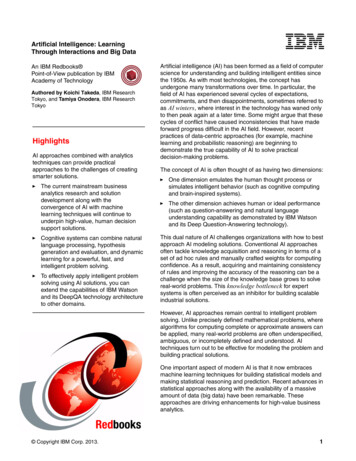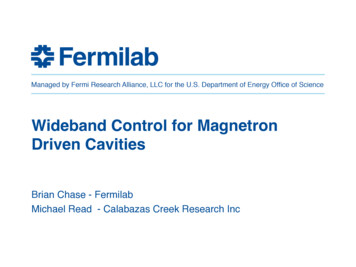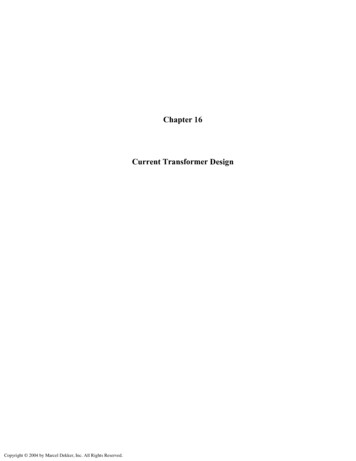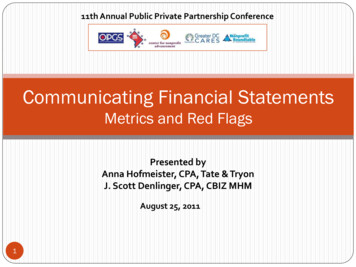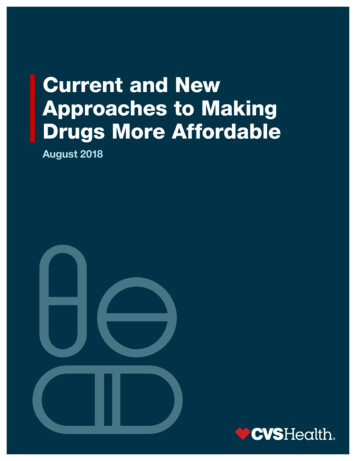
Transcription
Current and NewApproaches to MakingDrugs More AffordableAugust 2018
Our responsibility to our clients is to help ensure plan members take appropriate,cost-effective medications that improve health outcomes and lower overall medicalcosts. If price reductions by pharmaceutical manufacturers can help bring down drugcosts, then we are in favor of it. However, if only a few manufacturers make suchreductions, it may only affect a few medications.At CVS Health, we have undertaken comprehensive efforts to help reduce the cost of drugs. Our pharmacy benefitmanagement (PBM) business, CVS Caremark, employs three primary PBM techniques:Encourage the use of lower-cost alternatives, such as generic medications through step therapyUse prior authorization to help ensure patients utilize appropriate medications according toevidence-based rulesObtain lower costs for drugs by using competition to determine formulary placement when morethan one clinically equivalent drug is availableHowever, more needs to be done and additional innovations are necessary to help bring escalating drug prices andcosts under control. In this white paper we introduce some innovations that can further reduce costs and providegreater details on existing tools.Bringing Cost Inflation Under ControlWhile it is often lost in the debate over who is responsible for high drug prices, CVS Caremark has been ableto help improve adherence and keep drug cost inflation under control in spite of steady price increases bymanufacturers. In 2017, drug price growth for PBM clients was only 0.2 percent, despite manufacturer priceincreases of nearly 10 percent.1 Improvements in member adherence reduced overall health care costs for clientsby 600 million. This clearly shows PBM tools are helping control costs while also promoting better health throughgreater adherence to medications.PBM Strategies Kept Client Drug Costs in Check12.4%11.0%8.7%5.0%3.2%2015Unmanaged TrendSource: CVS Health Enterprise Analytics, 2018.2016Managed Trend1.9%2017In 2017, cost increase contributed 0.2%,utilization increase contributed 1.7%.CVS Health 2
These results aren’t unique to commercial clients. In fact, the Medicare Part D plans we serve have seen premiumincreases of less than 2.5 percent a year over the last five years. In 2016, drug prices for Medicare plans grew only1.5 percent, according to data published by the Centers for Medicare and Medicaid Services (CMS) Office ofthe Actuary.Data from the Federal Government Also Shows Decelerating Inflation in Drug tion DrugsNational Health ExpendituresSource: CMS Office of the Actuary, 2017.Three PBM Techniques for Managing CostsAs discussed, we use generics, prior authorization and step therapy, and formularyplacement to help lower drug costs for payors. Let’s look at each one more closely.Technique One: Encouraging Greater Use of GenericsU.S. Generic Market Share as Percentage of Total Prescriptions% of Total 70%60%20082009201020112012201320142017Source: IQVIA National Prescription Audit, Dec. 2017.The U.S. has by far the highest use of generics in the world — nearly 90percent — and most of this can be attributed to PBMs using step therapy.Step therapy requires that members utilize the most cost-effective,therapeutically equivalent alternatives — such as generics — first.Our research shows that use of generics actually improves outcomes andsaves lives. Greater use of generics for cardiovascular disease reduced riskof hospitalization for stroke and unstable angina, and led to a 3 percentdecrease in overall mortality, according to one study.2U.S. generic useis nearly 90%— almost doublethat of the OECDThe Organisation for Economic Co-operation andDevelopment is an intergovernmental economicorganization with 37 member countries.CVS Health 3
Generics Help Improve Adherence and Outcomes, Lower CostsHospitalization forAcute CoronarySyndrome7%Hospitalizationfor StrokeDeath fromany Causeimprovement indownstream adherence-3%Lower rates ofcardiovascular eventsand death-6%-8%Source: Gagne et al., Annals of Internal Medicine, 2014.Of course, this begs the question: If, as some assert, PBMs are only interested in higher prices, why do they pushlower-cost generics? The answer — and simple truth — is that the PBM business model is built on getting the lowestcost for medications, encouraging the use of the lowest-cost alternatives, and helping members achieve optimaladherence to medications.Manufacturers Use DTC Ads to Grow Sales forExpensive Branded Drugs 3.8B2013 4.5B2014 5.4B2015Drug manufacturers, on the contrary, fight theuse of generics by promoting their drugs throughphysician detailing and direct-to-consumer (DTC)advertising to build brand loyalty and then raisedrug prices. Use of DTC advertising for brandeddrugs has risen exponentially in the last severalyears, to nearly 5.5 billion. The poster child forthis is the expensive brand drug Humira, whose listprice doubled in the last six years. It's manufacturer,Abbvie, spent 429 million on promotion in 2017alone.3,4 The drug continues to be one of the bestselling drugs on the market.DTC Advertising SpendSource: Nielsen & Kantor DTC Spending Data, 2014-2015.Technique Two: Ensuring Appropriate Utilization Through Prior AuthorizationAnother way CVS Caremark helps reduce costs is through prior authorizationrequirements, which are simply a way of ensuring physicians are using the bestevidence-based rules and prescribing the most cost-effective medicationsfor patients. In 2017, the PBM reviewed 3 million prior authorization requests,saving payors more than 2.9 billion without reducing overall adherence. CVSHealth has also made dramatic strides in reducing the administrative burden forproviders by greatly broadening availability of electronic prior authorization.In 2017, CVS Caremarkreviewed 3 million priorauthorization requests,saving payors more than 2.9BCVS Health 4
Technique Three: Formulary ManagementCVS Caremark develops formulary plan design strategies to obtain rebates and discounts from pharmaceuticalmanufacturers on behalf of payors, to help control costs. Most drug classes have multiple competing drugs, whichclinical experts consider “clinically equivalent.” When that is the case, the PBM adds the drug with the lowestnet cost — that is, the manufacturer-set price minus the rebate or discount — and removes higher-cost clinicallyequivalent drugs within the same therapeutic class from the formulary. Drugs with lower manufacturer-set pricesneed smaller rebates to be competitive.Managed Formularies with Drug Removals Helped Reduce Costs, Improve Adherence4.2%2.6% 108.421.6%1.8% 88.941.7%-0.1%Drug Price GrowthUtilization TrendStandard Formulary without Drug RemovalsOverall Trend2017 Gross Cost PMPMManaged Formulary with Drug RemovalsSource: CVS Health Drug Trend Report 2017. Age-adjusted, post-rebate. CVS Health Managed Formularies: Include Standard with Opt-In to Drug Removals,Advanced Control Formulary, and Template Value Formulary.The competition between the long-acting insulin Lantus and the new biosimilar Basaglar is a great example of this.Clinical trials have shown Lantus and Basaglar to be clinically equivalent. In 2017, Lantus was removed from ourStandard Formulary in favor of Basaglar and other long-acting insulins. This resulted in 20,000 of 27,000 Lantus usersacross the CVS Caremark book of business moving to other more cost-effective therapies, many to Basaglar. Movingall users to Basaglar would lead to savings of more than 30 million per year.Independently ReviewedAll of our formulary decisions are based on the best possible medical evidence, includingguidelines from the leading medical specialty societies, and are reviewed by an external panelof experts, known as the Pharmacy and Therapeutics Committee. These experts are notCVS Health or CVS Caremark employees, and are also free of any financial relationship withpharmaceutical manufacturers. They approve every step therapy, every prior authorizationrequirement and every formulary change. Such use of an impartial, independent committee ofexperts by PBMs to approve business practices is unique within health care.CVS Health 5
The Myth about Rebates and List PricesPharmaceutical manufacturers insist that increasing drug prices are a result of them having to pay rebates. This issimply not true. If that was the case, rebates and list prices should be highly correlated. To the contrary, our datashow that in many cases list prices are increasing faster for drugs with smaller rebates than for medications withsubstantial rebates. Revlimid, manufactured by Celgene, is a good example. The price has tripled since 2005 tomore than 18,000, yet there are almost no rebates. The simple truth is, drug manufacturers take advantage of themonopoly granted by patents whenever possible, and there is no correlation between rebates and price increases.Rebates are possible only when there are equivalent competitor medications in a class, and we can use formularyplacement to drive lower costs.There is no Correlation Between Manufacturer-Driven Price Increases and Drug RebatesDrug CategoryList Price IncreaseAverage RebateAnticonvulsants46%6%Multiple Sclerosis27%7%Rheumatoid Arthritis50%10%Asthma/COPD20%25%Overactive Bladder39%26%DPP-4 Inhibitors (Diabetes)28%26%COPD (Chronic obstructive pulmonary disease).Source: CVS Health Enterprise Analytics, 2018. Cohort of commercial clients, Q2 2015-Q1 2018.Pharmaceutical manufacturers also argue that PBMs retain the rebates they negotiate, and that higher drug pricesmean more rebates and greater profits for PBMs. This is entirely false. Rebate retention also has no correlation tohigher drug prices. Indeed, our data show that while branded drug spend per CVS Caremark member has increasedfrom about 608 in 2011 to 831 in 2017, the average rebate retained by the PBM over that time is less than 20per member. The rebates CVS Caremark obtains from manufacturers are returned to clients to lower their costs.Competition among PBMs means more and more rebates are going back to clients. This is a good thing, and itdemonstrates that the market techniques used by PBMs are working.Higher Drug Costs Have no Correlation to Retained Rebates 1,000 800 686.8 622.0 608.9 600 831.3 791.7 754.4 609.4 40020112012Rebate Per Commercial Life2013Total Brand Dollars 26.3 20.7 18.1 16.0 21.0 0 125.7 102.4 91.1 78.0 254.4 237.5 206.5 20020142015 20.82016 15.02017 Retained/LifeIncludes commercial members in health plans, employers, Medicaid, and exchange plans.CVS Health 6
We should be clear about what happens with rebates. CVS Caremark clients — employers and insurers — userebates to lower the costs of providing insurance for their employees and members. For example, CVS Health, asan employer, spends 1.2 billion annually on health care benefits, of which, 250 million is for prescription drugs.As part of a standard contract, CVS Caremark returned 47 million in rebates to CVS Health. CVS Health, as anemployer, requires that rebates earned should be used to help our members with their out-of-pocket (OOP) costs.CVS Caremark offers this program — known as point-of-sale (POS) rebates — to any client. The program enablesthe plan to apply rebates at the point of sale (the pharmacy counter) to lower the cost of the drug when a memberis paying OOP or has coinsurance. Of the total rebates returned to CVS Health, 6.3 million in rebates were puttoward lowering OOP costs for our members, helping improve adherence by 4 to 6 percent. The remaining rebatesare used to reduce employees’ cost share, and to reduce costs overall to CVS Health as the employer.CVS Caremark retains rebates, with client approval, generally when the PBM goes “at risk” for a guaranteed levelof rebates. When CVS Caremark produces deeper discounts for a client than was guaranteed, it may retain theportion above the guarantee. Some clients prefer this approach, to ensure predictable costs. However, most clientsprefer total transparency and 100 percent rebate pass-through. CVS Caremark has an estimated rebate retention ofapproximately 2 percent thus far in 2018. By doing so, the PBM has kept drug price growth nearly flat.However, not all PBMs and insurers are as capable, and the high prices that manufacturers charge do get paid.That’s why the drug makers’ playbook is to constantly raise list prices and why their margins have remainedincredibly steady — and high. Only the constant increase in list prices can explain these margins, not newdiscovery — the new drug approvals over the last decade have averaged 32 annually, from a high of 46 in2015 to a low of 19 in 2016.5Annual Operating Margin for Top 15 Pharmaceutical 01425.0%201526.2%201625.1%2017Source: www.macrotrends.net. Operating margins defined as operating profit divided by annual revenue in aggregate for 15 pharmaceutical manufacturers.Pharmaceutical manufacturers identified based on annual 2017 revenues.CVS Health 7
Ongoing Innovation: Three New StrategiesThe three essential PBM techniques to help reduce costs are working, as demonstratedby drug costs for clients remaining essentially flat. However, we are not standing still.CVS Caremark continues to develop and implement new initiatives to help ensure thatpatients can get the medications they need. We believe three recent PBM innovationswill further lower the costs of medications:Assistance for patients in the deductible phase of their insurance, during which they shoulder all the costsAddressing the launch price of new medications, something PBMs have not historically been able to mitigateA renewed emphasis on transparency so that members, their doctors and their pharmacists canunderstand the true cost of a prescribed medication1. Zero Out-of-Pocket Costs for Chronic DiseaseFor the entire cohort of CVS Caremark members, average annual OOP costs are dropping, and were down to 11.89per-member-per-month in 2017. However, many standard insurer or employer plans increasingly use higher deductiblesto reduce overall costs of providing insurance, which places more of the financial responsibility on members. Memberswith a chronic disease who are in high deductible health plans (HDHPs) can have large OOP payments — 2.5 percent ofmembers have OOP costs of more than 1,000 annually. It is well known that if patients have high copayments, they areless likely to fill their prescription — referred to as prescription abandonment at the retail counter. This, of course, leads tohigher overall costs for payors, because patients who do not take their medications have poor health outcomes.Recognizing this, the federal government allowed HDHPs associated with health savings accounts (HSAs) under InternalRevenue Service (IRS) rules to create a preventive drug list, which enables plans to have zero-dollar copay for drugsthat prevent disease. The definition of “preventable” is somewhat flexible — CVS Caremark encourages clients to coverall generic medications for chronic diseases as well as some key branded drugs, like insulin, under this category.We recommend this wider “preventive” drug list for clients with any kind of HDHP, and believe that the governmentshould broaden the definition of what is considered a preventive drug. Research we recently completed indicates thatexpanding preventive drug lists to the five most chronic diseases — diabetes, hypertension, hyperlipidemia, asthma/COPD, and depression — could substantially improve care and lower costs. Our analysis shows that if clients employPOS rebates and follow the CVS Caremark Standard Formulary, they can implement a zero-dollar drug list for theseconditions, helping lower costs for their members while also saving money for the plan.Adding a Zero-Copay Chronic Drug List Reduces Cost 10M 17.3M 7Mtotal savings 0.3MMedical SavingsCore Gap SavingsProductivity SavingsSource: CVS Health Enterprise Analytics, 2018. Total projected health care cost savings from improved adherence per 100K commercially insured members.CVS Health 8
Zero-dollar member OOP costs could be revolutionary for diabetes and cardiovascular care, and would certainly bewelcomed by doctors and patient advocates. CVS Caremark can and does offer its zero-copay chronic drug list toemployers and insurers with standard HDHPs not employing HSAs. We should note that using rebates at the pointof sale is critical to this program, and we encourage PBM clients to apply POS rebates to help defray OOP costs fortheir employees. In summary, zero-dollar copays will lower costs for payors, and improve health for members. ForIRS-regulated HDHPs with HSAs, moving to zero-dollar copays for members with a chronic disease would requirechanges to IRS rules to broaden the preventive drug list. However, that small change will have a profound effect onlowering costs for consumers in the deductible phase and improve health outcomes.The rules governing HSAs should also be changed to give HDHPs the option to cover all prescription drugs —including generic and brand drugs — outside the deductible, so patients can access these drugs for little or no copayif that is how the plans want to structure their benefit.2. Reducing Launch Price Using Comparative EffectivenessThe second innovation to lower costs addresses the price at which a medication is launched — its initial price.Launch prices have been steadily rising for years, and are completely up to the discretion of the manufacturer.Quantitative methods, such as the concept of quality-adjusted life years (QALY), can help us compare the cost andeffectiveness of medications. In Europe, most medications are priced initially to produce effectiveness rated at 50,000 per QALY.The U.S. does not have any such programs. Launch prices continue to go up, into the hundreds of thousands ofdollars each year, pushing costs per QALY into the 300,000- 500,000 range — costs the U.S. health care systemsimply cannot absorb.High Launch Prices Contribute to Specialty SpendRuIbrRepCoax1997oneErenb1998lmHuira2002 145KabTys2004vldimisTariIn cai gnzCi m20062007i vekcTerafideSo val diak irVie kPaHar voancenVebrax tacle 200K 160K 120Kni 80K 2017 0average annual price of the last three approved oral oncology drugsSources: CVS Specialty analysis of Medispan data. Annual drug costs based on average wholesale price (AWP) accessed December 2017.CVS Specialty Analytics. Drug launch cost based on wholesale acquisition cost (WAC) launch pricing accessed Spring 2018.CVS Health 9
CVS Caremark is initiating a program that allows clients to exclude any drug launched at a price of greater than 100,000 per QALY from their plan. The QALY ratio is determined based on publicly available analyses from theInstitute for Clinical and Economic Review (ICER), an organization skilled in the development of comparativeeffectiveness analyses. Medications deemed “breakthrough” therapies by the U.S. Food and Drug Administrationwill be excluded from this program, which will focus on expensive, “me-too” medications that are not cost effective,helping put pressure on manufacturers to reduce launch prices to a reasonable level.We believe as more PBM clients adopt such programs, manufacturers will begin to moderate launch prices. No onebut manufacturers have, until now, had any control over the launch price of newly patented drugs. This new approach,harnessing the power of the market, could change manufacturer behavior. CVS Caremark continues to use other PBMtechniques to help lower costs for payors and their members, but lower launch prices could help bring about realdeflation in drug prices.3. Transparency in Drug CostsThe third new strategy centers on greater transparency in drug pricing and costs. We are addressing this with a seriesof tools that can be used by doctors, pharmacists, and consumers to understand the real costs of drugs. The firststep is to get doctors and other providers engaged in cost control at the time a prescription is written. Right now, theprovider chooses a medication largely without visibility into the cost to the member.To address this lack of visibility, we now provide real-time benefit information to doctors to help ensure they have up-tothe-minute, member-specific coverage and pricing information, as a prescription is being written. We enable prescribersto see:The true cost of the drugThe amount the member will have to payA list of therapeutic alternatives and the cost of each alternativeThis is not information physicians are used to seeing, but preliminary data suggest if they have access to it, they arelikely to take the right action to save patients money. For prescriptions written by physicians using real-time benefitinformation, when a lower-cost preferred alternative is presented, physicians are switching to the lower-cost alternative40 percent of the time. In these cases, the member cost was 130 lower per fill compared to the original non-preferreddrug selected.The same information is also available to pharmacists at CVS Pharmacy locations through a tool called Rx SavingsFinder, which enables them to quickly and seamlessly evaluate individual prescription savings opportunities andwork with members and their doctors to get the lowest-cost medication prescribed. And the same information is alsoavailable to all PBM members through the Check Drug Cost Tool on the CVS Caremark app and member portal. Whenmembers use the Check Drug Cost tool to access real-time benefit information, they switch to a lower-cost alternative20 percent of the time, saving 120 per fill. We firmly believe that transparent access to drug cost information is the bestapproach to reducing costs.These three new strategies can help lower costs as a complement to traditional PBM tools.CVS Health 10
Lowering Drug Prices to Improve HealthThe most important thing CVS Caremark can do for PBM clients is to help ensure people take their medications— doing so improves overall health and lowers cost. But to accomplish this, medications must be affordable. Thetechniques we have used to this point are based on evaluating the comparative effectiveness of various medicationsbased on clinical evidence and using market techniques to ensure the lowest possible cost. The proposed innovationsbuild on that base of clinical evidence and health care economics to address two key aspects of the drug cost crisis:burdensome OOP payments and ever-higher drug launch prices.These innovations will do two things: help patients afford the medications they need, and lower profit margins forpharmaceutical companies. However, lower profits should not impede discovery. Today, drug manufacturers spendmore money on marketing than discovery. These marketing expenditures can be shifted, thereby refocusing the drugmanufacturing industry on its primary goal — the discovery of new treatments for illness.Pharmaceutical Manufacturers Can Afford to Lower Prices and Still Have Decent MarginsPercent MarginPharmaceuticals23%Beverage andTobacco20%All Manufacturing9%Machinery8%Oil andNatural Gas6.7%Plastics andRubber6%PBMFood3.5%2%Drug Industry Rate of Profit (Return on Equity)All Industry Rate of Profit (Return on Equity)Source: U.S. Census Bureau, 2012; Public Citizen, 1999.1. 2017 AWP trend pre-rebate was 9.2% for traditional brands, based on claims for our Commercial Cohort (employers and health plans). Calculated by CVS Health Enterprise Analytics, April 2018.2. https://www.ncbi.nlm.nih.gov/pubmed/2522238.3. Humira’s Best-Selling Drug Formula: Start at a High Price. Go Higher. NY Times, Jan 6, 2018. -drug-prices.html.4. 1/.5. o-2022.Data Source: CVS Health internal data unless otherwise noted.Adherence results may vary based upon a variety of factors such as plan design, demographics and programs adopted by the plan.Client-specific modeling available upon request.This document contains references to brand-name prescription drugs that are trademarks or registered trademarks of pharmaceuticalmanufacturers not affiliated with CVS Health.Savings will vary based upon a variety of factors including things such as plan design, demographics and programs implemented by the plan.This page contains trademarks or registered trademarks of CVS Pharmacy, Inc. and/or one of its affiliates. 2018 CVS Health. All rights reserved. 106-46485A080818
The competition between the long-acting insulin Lantus and the new biosimilar Basaglar is a great example of this. Clinical trials have shown Lantus and Basaglar to be clinically equivalent. In 2017, Lantus was removed from our Standard Formulary in favor of Basaglar and other long-acting insulins. This resulted in 20,000 of 27,000 Lantus users
